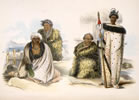Maruiwi
Around the time of Toi, who was one of the first explorers to reach New Zealand from Hawaiki, the Maruiwi people inhabited lands throughout the central North Island. Their territory stretched from the Tāmaki isthmus to the eastern Bay of Plenty and Hawke’s Bay. They were eventually pushed out of various settlements through either local resentment of their presence or other provocations.
Leaving the eastern Bay of Plenty, the Maruiwi tribe stopped a while in Kawerau. Here they incurred the wrath of Tūwharetoa’s sons, who went against their father’s better judgement and pursued them. However, when the two tribes fought at Kākatarae, the Tūwharetoa forces were no match for the Maruiwi, and many important Tūwharetoa chiefs and warriors of noble rank were killed or taken prisoner. Tūwharetoa’s son Rongomai-te-ngāngana was also killed. The place where their bodies were piled against a tree was called Ōwhakatihi.
However, Rongomai-te-ngāngana’s second son escaped to Taupō. He would later take the name Whakatihi in memory of his slain father. Whakatihi is a well-known Ngāti Tūwharetoa name.
Ngāti Hotu
The Ngāti Hotu people were living in the Taupō district when the priest Ngātoroirangi and explorer Tia arrived. The tribe were referred to as ‘urukehu’ (fairy people) because of their unusual red hair and fair skin.
Threatened with invasion by Tūwharetoa groups from Kawerau, Ngāti Hotu sought to defend their rights. The chiefs of Tūwharetoa at the time were Tūrangitukua, Waikari and Ruawehea. With the support of Tūtewero from Kawerau the chiefs overwhelmed Ngāti Hotu, and the tribe of Tūwharetoa established its mana in the Taupō region.
Intertribal and inter-hapū warfare
Ngāti Tūwharetoa history tells of many battles with other tribes and among their own hapū (sub-tribes) until the 19th century. Ngāti Whiti, Ngāti Apa and Ngāti Tama played major roles in the Ngāti Tūwharetoa story.
Tribal chiefs
Te Rangiita and his son Tamamutu were prominent warrior chiefs who established important territorial connections. But it was Rangituamātotoru, the great-grandson of Tamamutu, who set a high standard of leadership as paramount chief.
Born too late
The chief Horonuku, descended from Herea, was convinced that his first child would be a boy, so he blew a trumpet heralding its arrival. In fact, the child was a girl. When a boy did arrive two years later there was no trumpet sound, and the boy was named Tūreiti – a transliteration of ‘too late’.
The Te Heuheu dynasty
The Te Heuheu paramountcy began with Herea at the end of the 18th century. He defeated renowned warrior chief Te Wakaiti in close combat at Pukawa, to become the undisputed chief of the Taupō region.
The family name, Te Heuheu, comes from an incident when Herea and others went to retrieve the body of a relative. The party had difficulty finding the body because it was hidden by an overgrown shrub known as māheuheu.
Herea became known as Te Rangimā-heu, and it was this name change that marked the beginning of the Te Heuheu reign. Herea’s wife Rangiaho also named her newborn child Te Heuheu Tūkino. Eventually Herea too adopted the Te Heuheu name.
The paramountcy is passed down through the Te Heuheu family lines to the eldest son.


